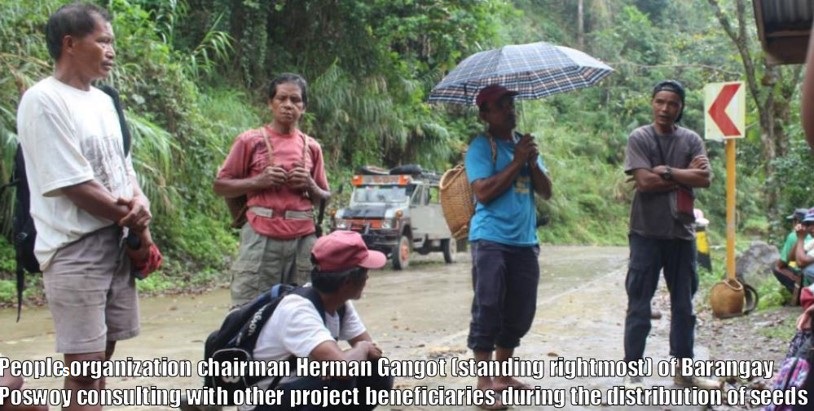Kalinga, Philippines – Hernan Gangot, 50, a local farmer and the chairman of people’s organization in Brgy. Poswoy in the Municipality of Balbalan, in the province of Kalinga, looks problematic yet calm. Despite being troubled by the previous typhoon, Hernan remains hopeful.
His skin was almost toasted by the sun, as he spent his entire life enduring the backbreaking work from sunup till sundown. His grey hair proves his constant worry about making ends meet and the threat of severe weather destroying crops. Herman is also the pillar of his home with five children he feeds through farming. Hernan and his family solely rely on their agriculture crops to survive. However, there might not be enough food to put on their table as climate change intensifies. Like other residents of Balbalan, Hernan fears of not being able to grow enough yields to meet his family needs.
In the last 40 years, according to a study, the destructive power of typhoons that wreaked havoc across Asian countries including the Philippines has intensified by 50%. Incrementing number of unpredictable rains in a year and prolonged dry periods doubled the burdens of every farmer in the Philippines like Hernan.
In 2018, many typhoons made its landfall in the Philippines, particularly in most part of Central Luzon including Herman’s community in Brgy. Poswoy. Typhoon Ompong (international name Mangkhut) is one of the typhoons which brought devastating rains and flooded entire communities that year. It claimed lives and destroyed sources of livelihood in bigger portions of the Cordillera Region.
Barangay Poswoy is a far-flung community and one of the largest barangays in terms of land area in the municipality of Balbalan. The main source of livelihood in the area is agriculture where people practice wet and dry farming. This makes them vulnerable to hazards such as typhoons and droughts. The inhabitants of the community need to travel for half a day to reach the central business district of the province to purchase commodities. This comes with additional expenses for transportation, food and lodging. The barangay is underdeveloped as people have some difficulties in accessing health and educational facilities.
Due to its location, people are compelled to live in self-sufficiency. They need to find ways to obtain basic needs such as food, water and shelter. Food security has been one of the main issues in the area.
This farming community was devastated Ty Ompong. Aside from significant shelter damages to the houses of the residents, food source has been greatly affected because high-value crops of the community were not spared from the typhoon’s wrath. This aggravated pre-existing lack of access to food and clean water. Severe damages to lives and livelihood put Hernan and the rest of the small-holder farmers in Brgy. Posey in a very oppressive situation.
The presence of the local people’s organization enables the community to be resilient in times of disasters. However, their capacity would not be enough in times of large, devastating disasters. Calamities like Ty Ompong would force the community to rely on external help. What’s more, the community’s geographical features hinder the government from delivering social services to the area which exacerbates the community’s socio-economic vulnerabilities.
After the typhoon, the CDRC emergency response team quickly jumped into action and began to provide assistance to those affected by the typhoon. Alongside partners like the Cordillera Disaster Response and Development Services, Inc. (CorDisRDS), they provided immediate relief such as food and clean water and other basic necessities.’
CorDisRDS and CDRC provide immediate relief to communities affected by disasters whenever possible. Not only that, they also adhere to helping communities on their way to recovery. With the grant provided by a humanitarian agency and the Citizens’ Disaster Response Network’s long-time partner Diakonie Katastrophenhilfe (DKH), CorDisRDS delivered its recovery support by giving vegetable seeds to the hardest-hit families including Hernan. Each beneficiary received one kilogram of climbing beans, six grams of bitter gourd seeds, thirty grams of pechay seeds, and twenty grams of string beans seeds. The soft component of the project included orientations on Disaster Management and Sustainable Agriculture. This training aim to increase the resilience of beneficiaries like Hernan to natural disasters and their ability to recover. Farmers are taught to produce home-made organic fertilizers.
The provision of agricultural support mitigated the risk of food insecurity in the community. According to Herman, the yield of the provisions would provide them with a food sources that could last up to six months. He said that the provisions would greatly help his family. With additional yield aside from the crops that they are normally planting, they will no longer be bothered by the thought of being hungry. The vegetables also proved helpful during disasters as exhibited by the current pandemic. Aside from Hernan, other community members said that their harvest became their food source during the lockdown.
Despite the devastation they had just gone through, Hernan remains optimistic in life. As an official of the people’s organization, he affirms that an organization unites the community under a common goal. This is evident in the smooth implementation of the early recovery project supported by Diakonie Katastrophenhilfe.
While severe weather events may be part of a farmer’s life, with the learnings they earned from the provided training and with the help of his PO’s members, Hernan is confident that he is now prepared to face whatever storm comes his way.

